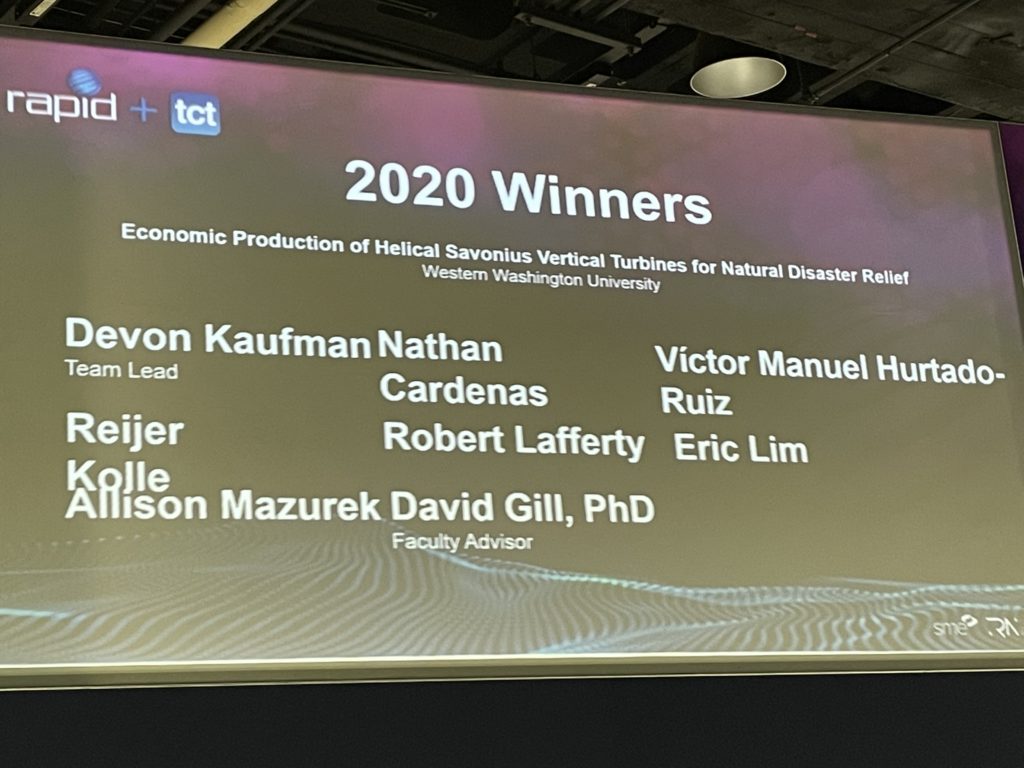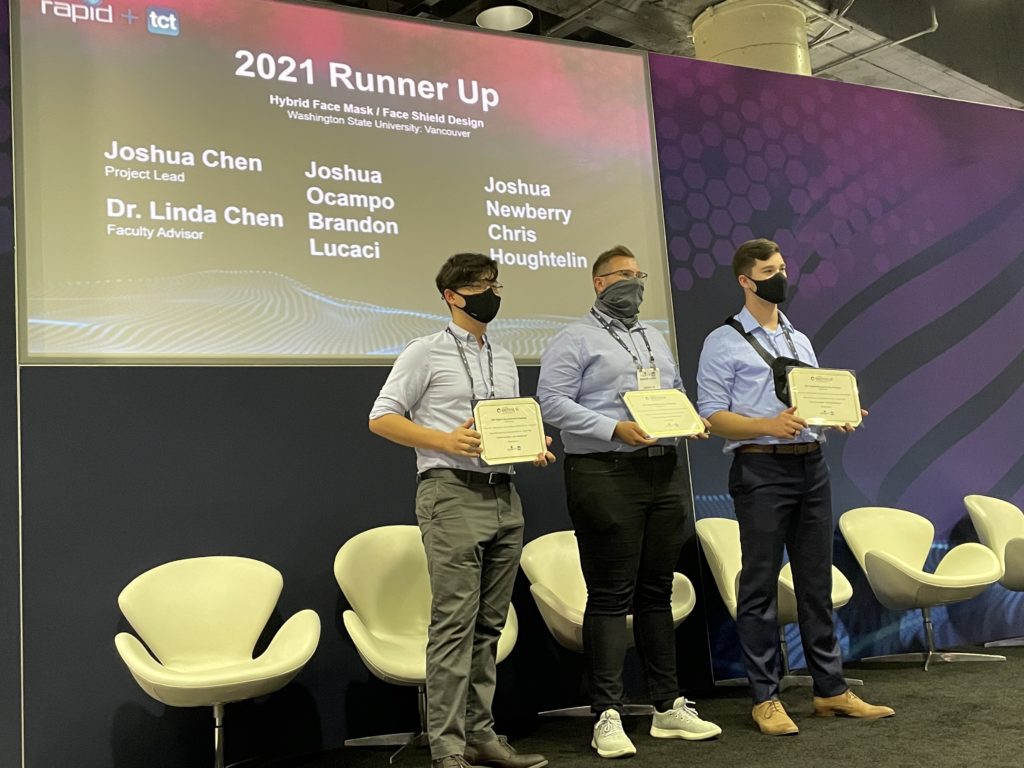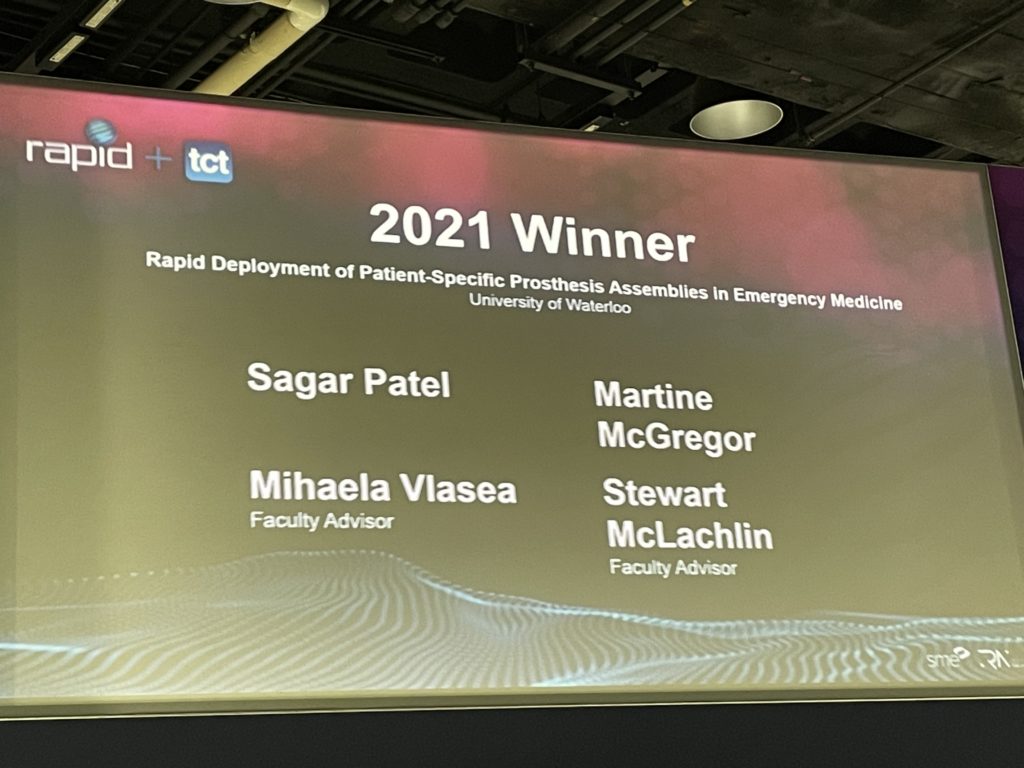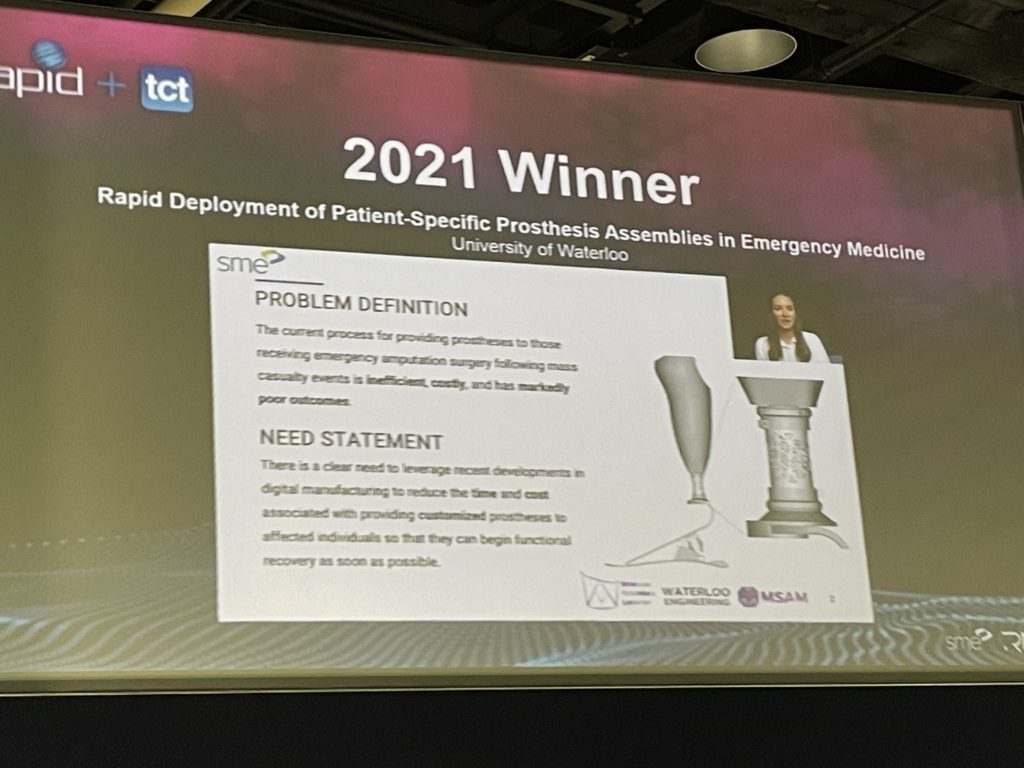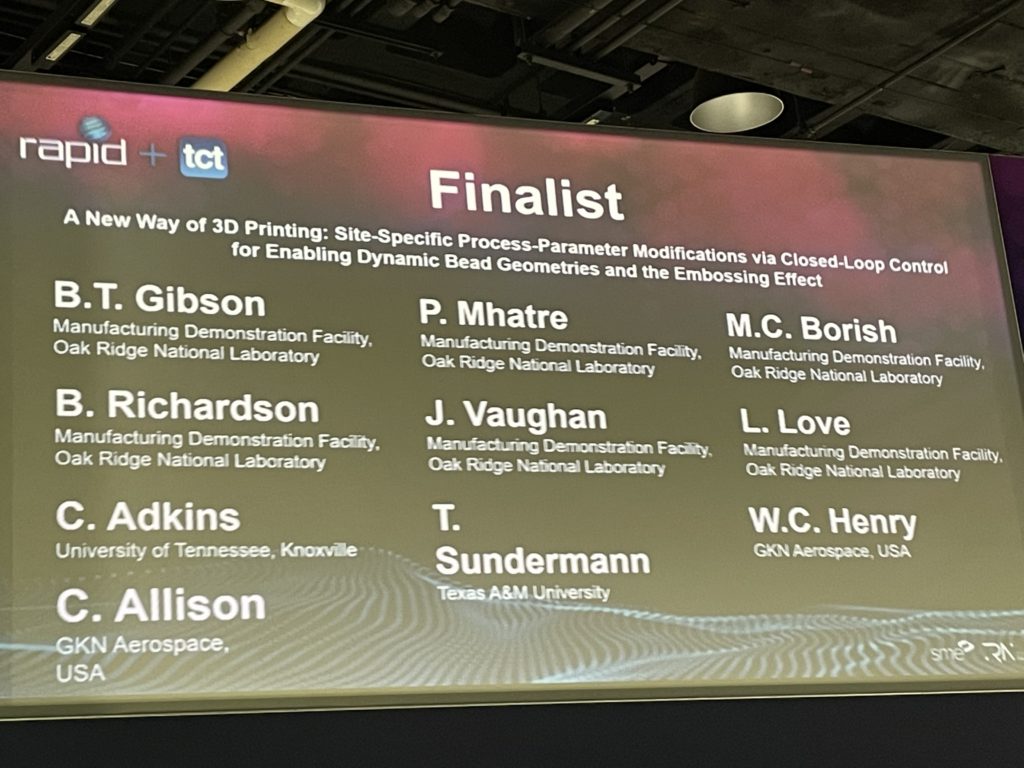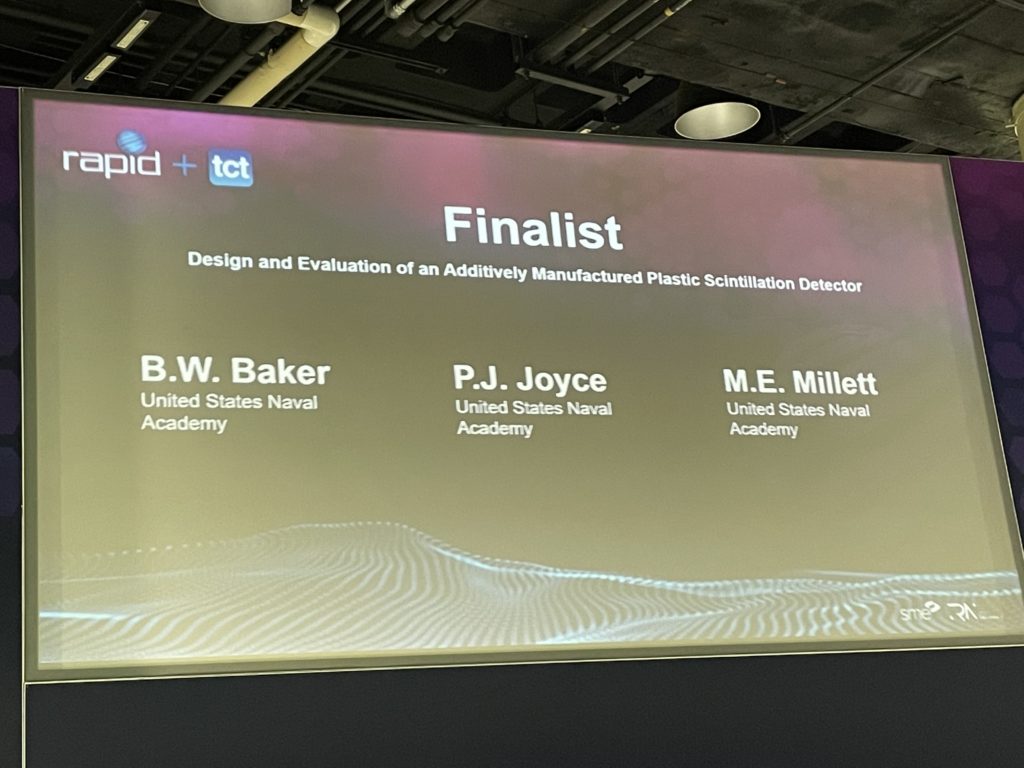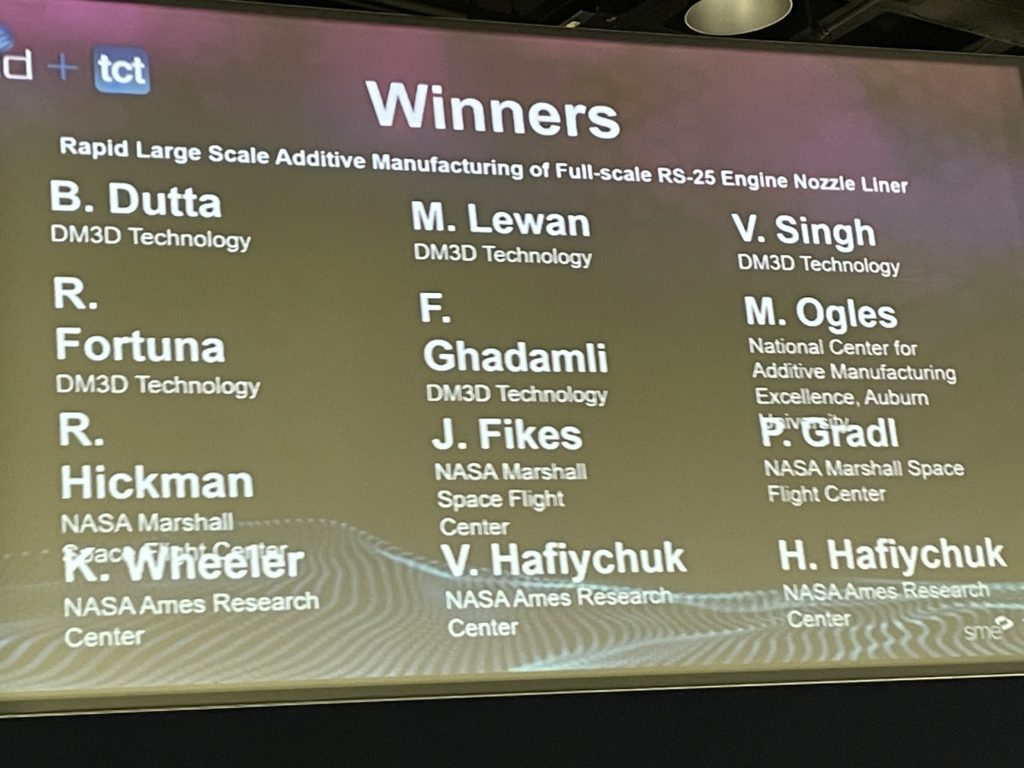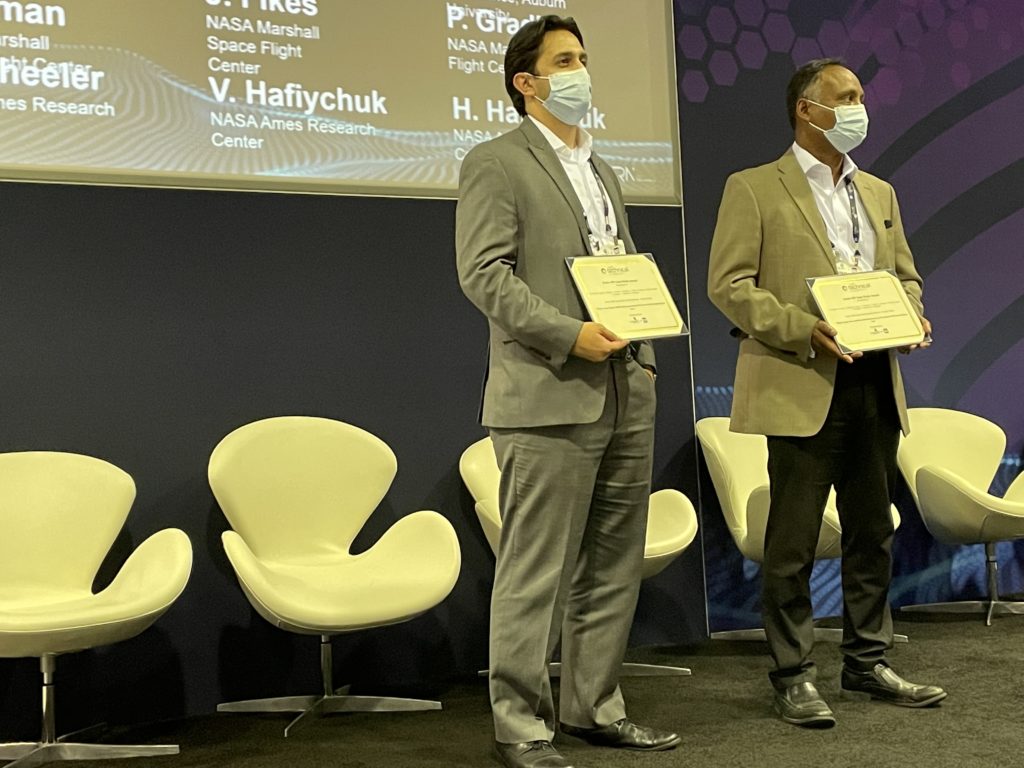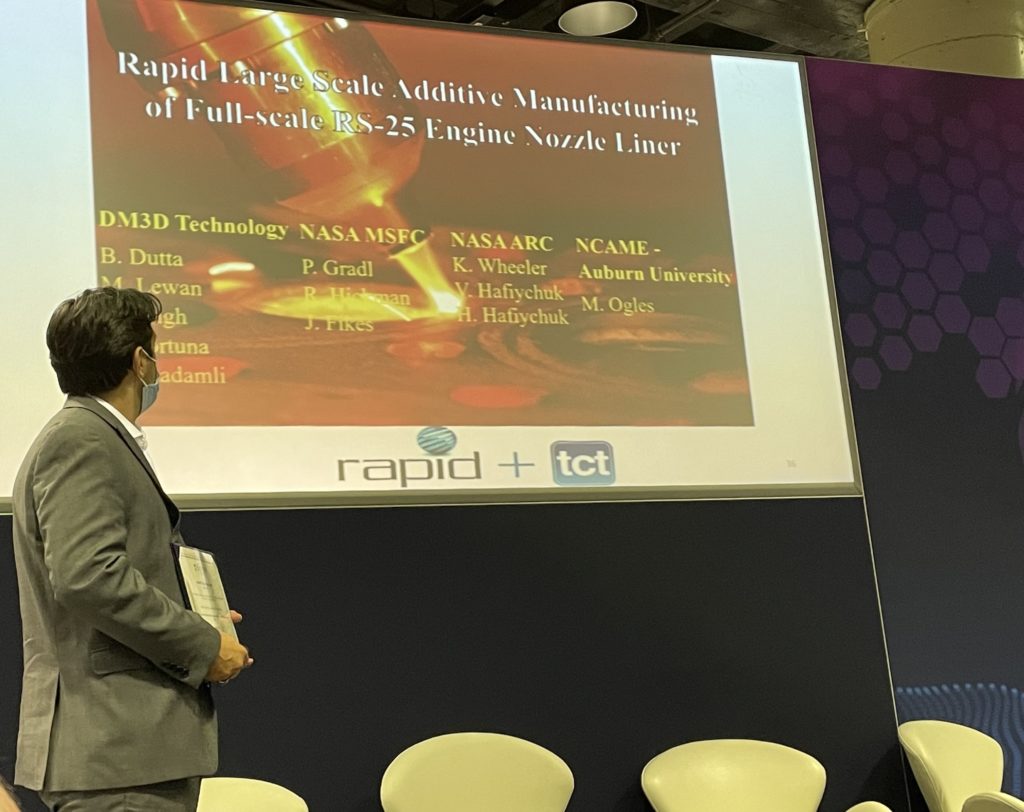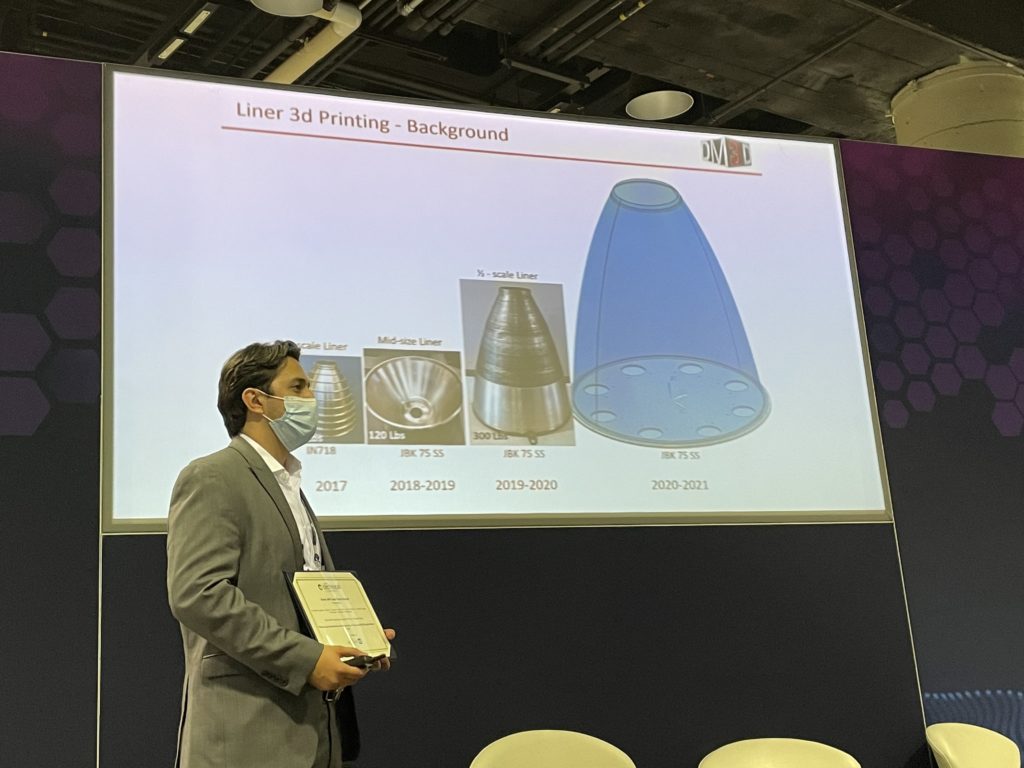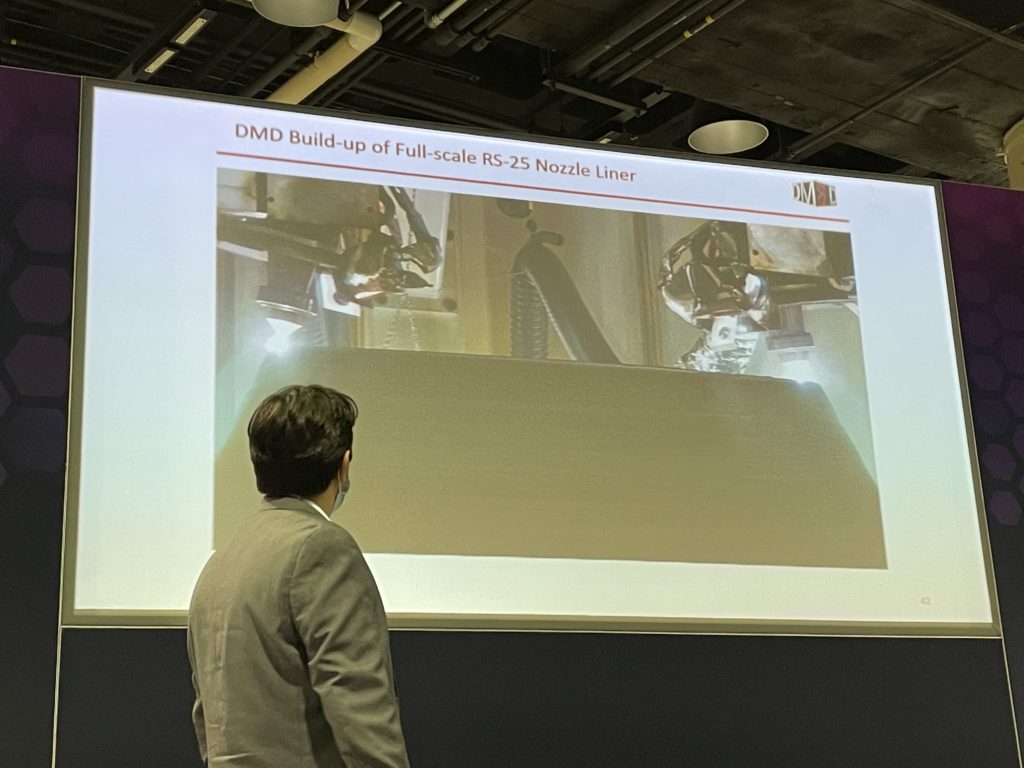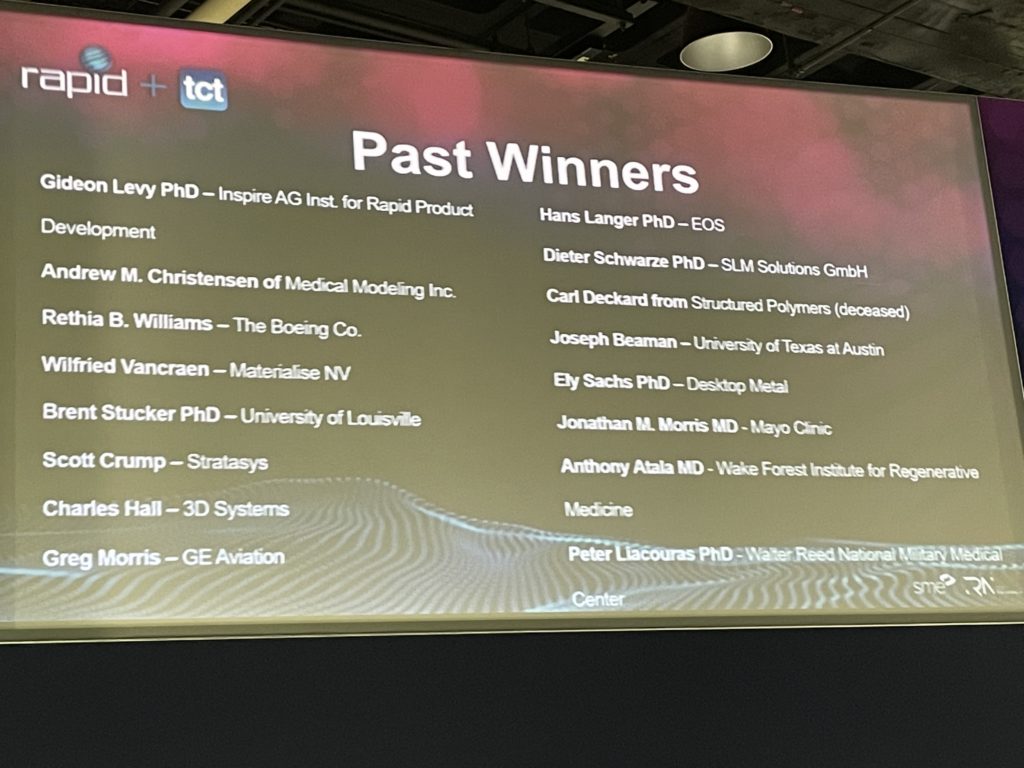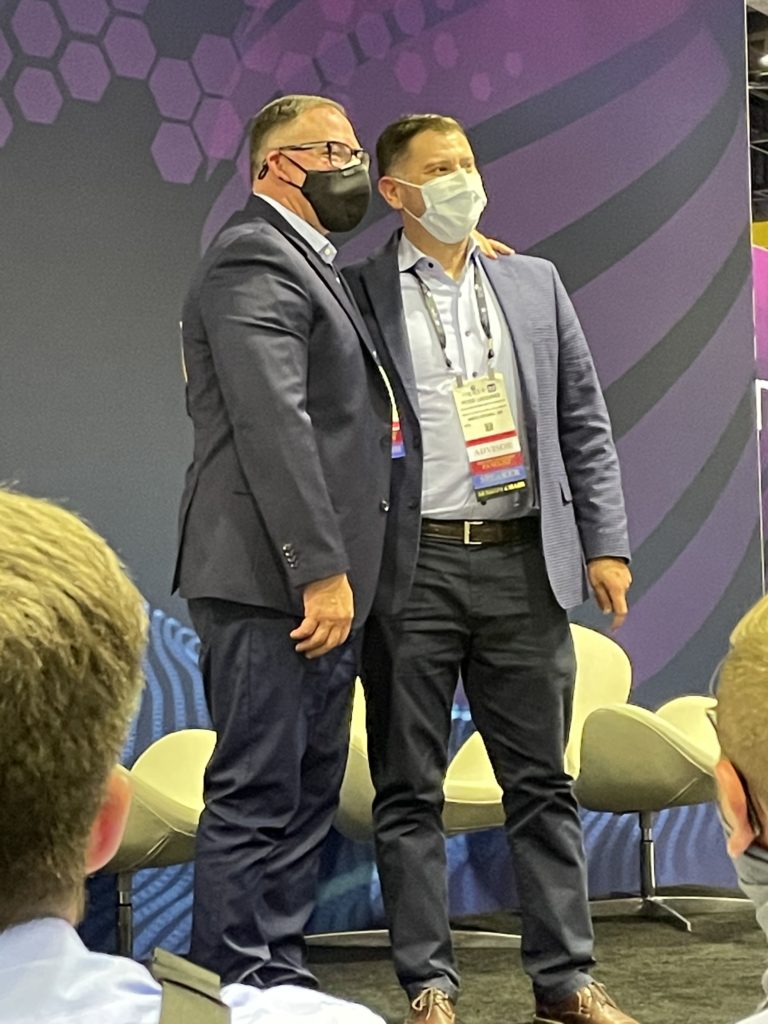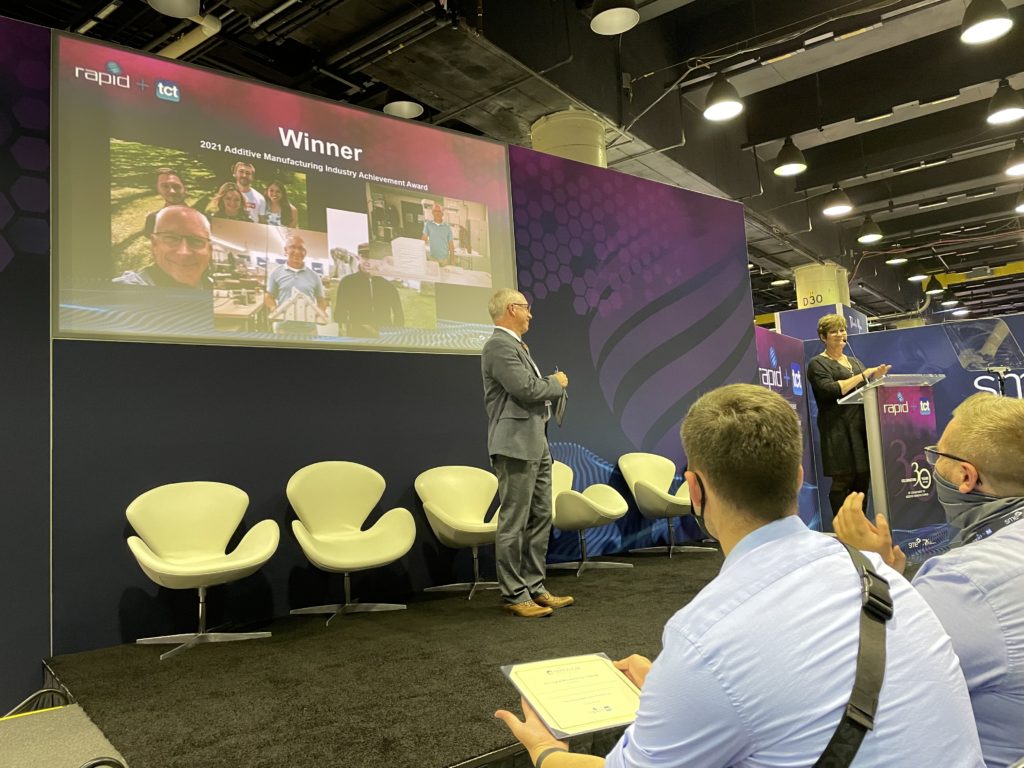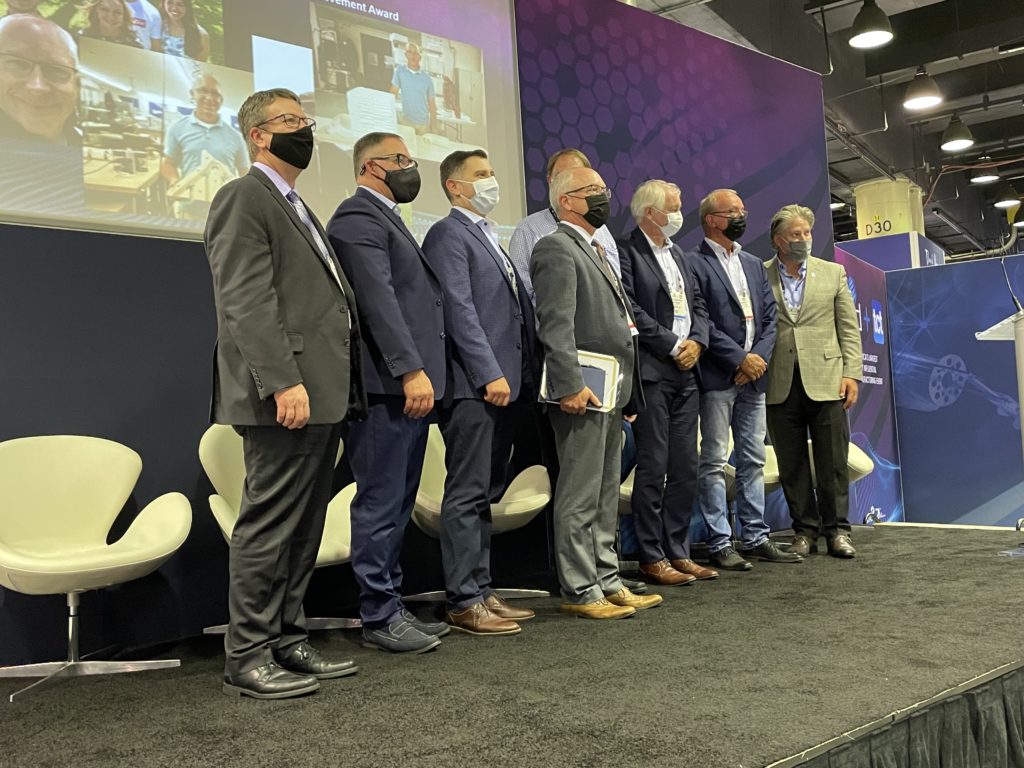At the recent RAPID + TCT 2021 event, in between interviewing companies, walking the show floor, and watching the keynote presentations, I also had the opportunity to attend the SME Additive Manufacturing Community Awards, presented by the SME Technical Community. The presentation encompassed the Digital Manufacturing Challenge Awards, the Aubin AM Case Study Award award, and the AM Industry Achievement Award, and were presented by Stacey DelVecchio, F.SWE, the President of StaceyD Consulting, and Kevin Ayers, AM Consultant with 3D Metal Konsulting.
First up were the awards for the Digital Manufacturing Challenge, which calls on student designers to use their imaginations to come up with an innovative design that “exploits the geometric capabilities of direct digital manufacturing (DDM) to the fullest.”
First, because RAPID was cancelled last year due to the pandemic, the 2020 challenge winners from Western Washington University were recognized for their project, “Economic Production of Helical Savonius Vertical Turbines for Natural Disaster Relief.”
This year’s Digital Manufacturing Challenge was described as a call to inspire the next generation of AM professionals and engineers to use the many and varied digital manufacturing tools out there, including 3D printing and subtractive processes, to create things that can help strengthen the infrastructure in the face of disruptive events, such as COVID-19. Students were asked to consider how they can use the tools of DDM to improve security and sustainability, while also preserving health and well-being.
“The imperatives of exponential growth exhibited by the coronavirus pandemic challenge us to think beyond reactive and proactive to execute predictively by employing system-level tools such as big data and infrastructure modeling to anticipate and coordinate in real time with and among all involved and affected communities,” the challenge description reads. “Given the lessons continuing to be learned, the 2021 Digital Manufacturing Challenge is a call for action to inspire the next generation of engineers to re-think ways to design, create, and utilize infrastructure-level systems that deploy engineering design and manufacturing solutions to strengthen infrastructure in the response, mitigation and/or prevention of such disruptive and devastating events and envision an optimistic view of healthy, robust, sustainable, smart, agile, peaceful communities.”
Teams were asked to demonstrate new and creative ways that digital manufacturing can add value in coming up with point-of-care solutions that feature rapid deployment of an end-to-end system, rather than just a single component. Entries were judged based on a number of criteria, including cost-benefit/value analysis of why AM was or was not used, utilization of DDM processes and materials, marketing and logistics/distribution, social, environmental, health, safety, and regulatory compliance, and more.
First, the 2021 Honorable Mention team from UC San Diego was announced, with their project “Vacuum Flasks Designed for Cold Supply Chains with Additive Manufacturing.”
Then, the 2021 Runner Up team, from Washington State University: Vancouver, was announced, with their project “Hybrid Face Mask / Face Shield Design.” We definitely saw a lot of 3D printed face masks and shields in 2020, thanks to the pandemic.
The winner of the 2021 Digital Manufacturing Challenge was the team from the University of Waterloo, with their “Rapid Deployment of Patient-Specific Prosthesis Assemblies in Emergency Medicine” project.
Moving on, the Aubin AM Case Study Award, which has been newly rebranded and updated, recognizes innovative use cases in AM adoption, be it unique technology adoption showcases in broad application areas, new technological advancements in AM materials and processes, or unique approaches to using AM for problem-solving.
Submissions had to include a graphical abstract—one single image that represents the applicant’s innovation/showcase/solution—as well as a technical brief, the purpose of which is to is explain the details of the innovation or case study they’re submitting. The brief had to include a list of contributors, why the solution was disruptive and needed, how it compares to the existing state of the art case, an assessment demonstrating the quality of the solution, and personal reflections on the impact and relevance of the submission.
“The panel of judges will evaluate the submitted technical briefs based on the level of technical detail, quality of analysis of the innovation, and its perceived usefulness to the broader AM community.”
There were three finalist teams that came very close to winning the award, and the first had participants from the University of Toronto’s Radiation Oncology, Sunnybrook Health Sciences Centre, and Molli Surgical Inc., who created 3D printed custom applicators for treating skin cancer patients with brachytherapy.
The second team, which developed a new way of 3D printing dynamic bead geometries using site-specific process parameter modifications through closed loop control, was mostly from the Oak Ridge National Laboratory’s Manufacturing Demonstration Facility, along with participants from GKN Aerospace, Texas A&M University, and the University of Tennessee – Knoxville.
The third team, a trio from the United States Naval Academy, designed and evaluated a 3D printed plastic scintillation detector.
The winner of the 2021 Aubin AM Case Study Award was a team that worked on “Rapid Large Scale Additive Manufacturing of Full-scale RS-25 Engine Nozzle Liner.” Participants were from DM3D Technology, NASA Marshall Space Flight Center, NASA Ames Research Center, and the National Center for Additive Manufacturing Excellence at Auburn University.
DM3D Technology’s president, Bhaskar Dutta, and Farhad Ghadamli, the company’s Lead Additive Manufacturing Engineer, came on the stage to talk about the team’s 3D printed nozzle liner.
As Dutta explained, the team used a multi-nozzle system to print the nozzle liner, and doubled the throughput of the process thanks to two nozzle heads. JBK-75 stainless steel was used to fabricate the piece, which Dutta said is “really tough to print” but great for aerospace applications.
The engine nozzle liner was printed bell-down for less distortion, and the Hexagon StereoScan neo optical 3D scanner was used to take structured light scans, and then the data was overlaid on the CAD file. The final product took between 10 and 11 weeks to print, and weighs in at 4,000 lbs, with a height of 111″.
“We achieved an estimated 25% cost savings for this very expensive part, so there’s a strong business case,” Dutta concluded.
Finally, it was time to present the 2021 AM Industry Achievement Award, which was established in 2008 by SME’s Additive Manufacturing Community to recognize a company, team, or individual for “outstanding accomplishments” that have significantly impacted the AM industry, or any industry through the use of AM.
“As the name suggests, the award recognizes achievements that have been implemented or deployed in a commercial/industrial environment rather than research investigative work. Winners are selected with consideration for the scope and scale of benefits realized and the potential future impact their work will have on the industry.”
As with the Digital Manufacturing Challenge, the 2020 winners were recognized first: Jonathan M. Morris, MD, Mayo Clinic; Anthony Atala, MD, Wake Forest Institute for Regenerative Medicine; and Peter Liacouras, PhD, Walter Reed National Military Medical Center. Dr. Morris and Dr. Liacouras came onstage to be honored, but Dr. Atala was unfortunately not there.
Then it was time to announce this year’s winner, an industry veteran who has been working in additive manufacturing since 1989. David K. Leigh, PhD, joined 3D Systems as its Chief Technology Officer for Additive Manufacturing just this summer; he was most recently the CTO at EOS, and has also held executive positions at Vulcan Labs, Stratasys, 3DSIM, Advanced Laser Materials, and other companies as well.
“Dr. Leigh is recognized for his career-long contributions to the AM industry. He has been instrumental in pioneering standards and specifications on qualification of AM; building successful culture and systems at printing service houses; and founding (and eventually spinning off) companies that broadened the market and audience for AM technology.”
Dr. Leigh holds a Bachelor of Science in Mechanical Engineering, a Master of Science in Engineering, and a Doctorate in Materials Science and Engineering, all from the University of Texas at Austin, which is a major AM research university.
“I was honored that I was even nominated, and that I went through the process. Honestly, I’m very humbled to have gone through that process and end here,” he said. “I really wanted to give a charge, from the people that I’ve met along the way.”
Dr. Leigh shared some important lessons he’s picked up in his career from various colleagues. He said that in order to make a difference, you need to:
- Get involved
- Don’t make excuses
- Be willing to do the hard work
“My own personal charge is don’t give up,” he concluded, stating that his own career in manufacturing began as a field service engineer.
I was able to sit down with Dr. Leigh the next day to discuss 3D Systems, why he chose it, and learn a little more about the company’s acquisition of Oqton, so stay tuned for that, and more of my coverage from the RAPID + TCT 2021 show floor.
3DPrint.com congratulates all who were recognized at this year’s SME Additive Manufacturing Community Awards!
Subscribe to Our Email Newsletter
Stay up-to-date on all the latest news from the 3D printing industry and receive information and offers from third party vendors.
Print Services
Upload your 3D Models and get them printed quickly and efficiently.
You May Also Like
Reinventing Reindustrialization: Why NAVWAR Project Manager Spencer Koroly Invented a Made-in-America 3D Printer
It has become virtually impossible to regularly follow additive manufacturing (AM) industry news and not stumble across the term “defense industrial base” (DIB), a concept encompassing all the many diverse...
Inside The Barnes Global Advisors’ Vision for a Stronger AM Ecosystem
As additive manufacturing (AM) continues to revolutionize the industrial landscape, Pittsburgh-based consultancy The Barnes Global Advisors (TBGA) is helping shape what that future looks like. As the largest independent AM...
Ruggedized: How USMC Innovation Officer Matt Pine Navigates 3D Printing in the Military
Disclaimer: Matt Pine’s views are not the views of the Department of Defense nor the U.S. Marine Corps Throughout this decade thus far, the military’s adoption of additive manufacturing (AM)...
U.S. Congress Calls Out 3D Printing in Proposal for Commercial Reserve Manufacturing Network
Last week, the U.S. House of Representatives’ Appropriations Committee moved the FY 2026 defense bill forward to the House floor. Included in the legislation is a $131 million proposal for...


